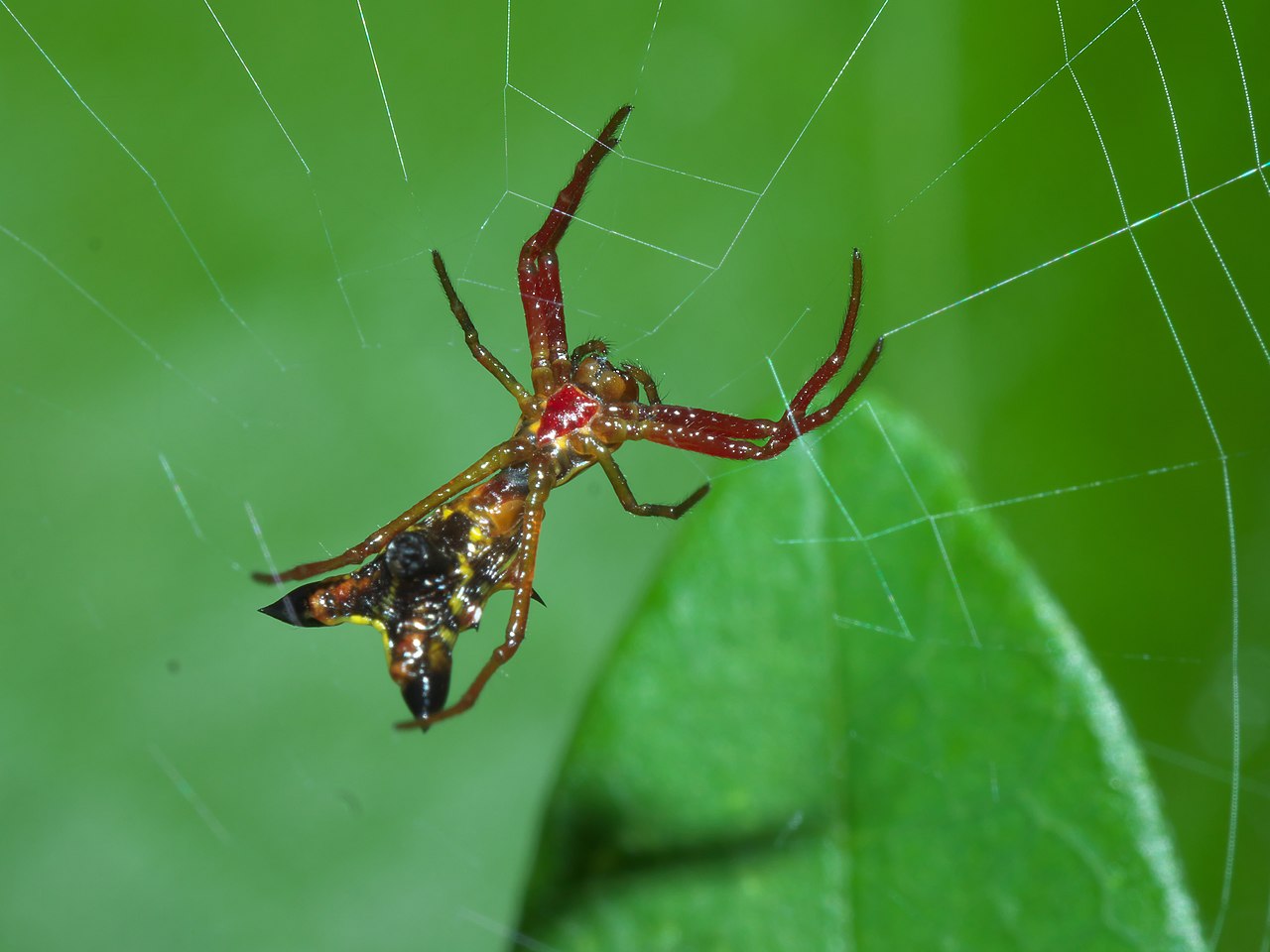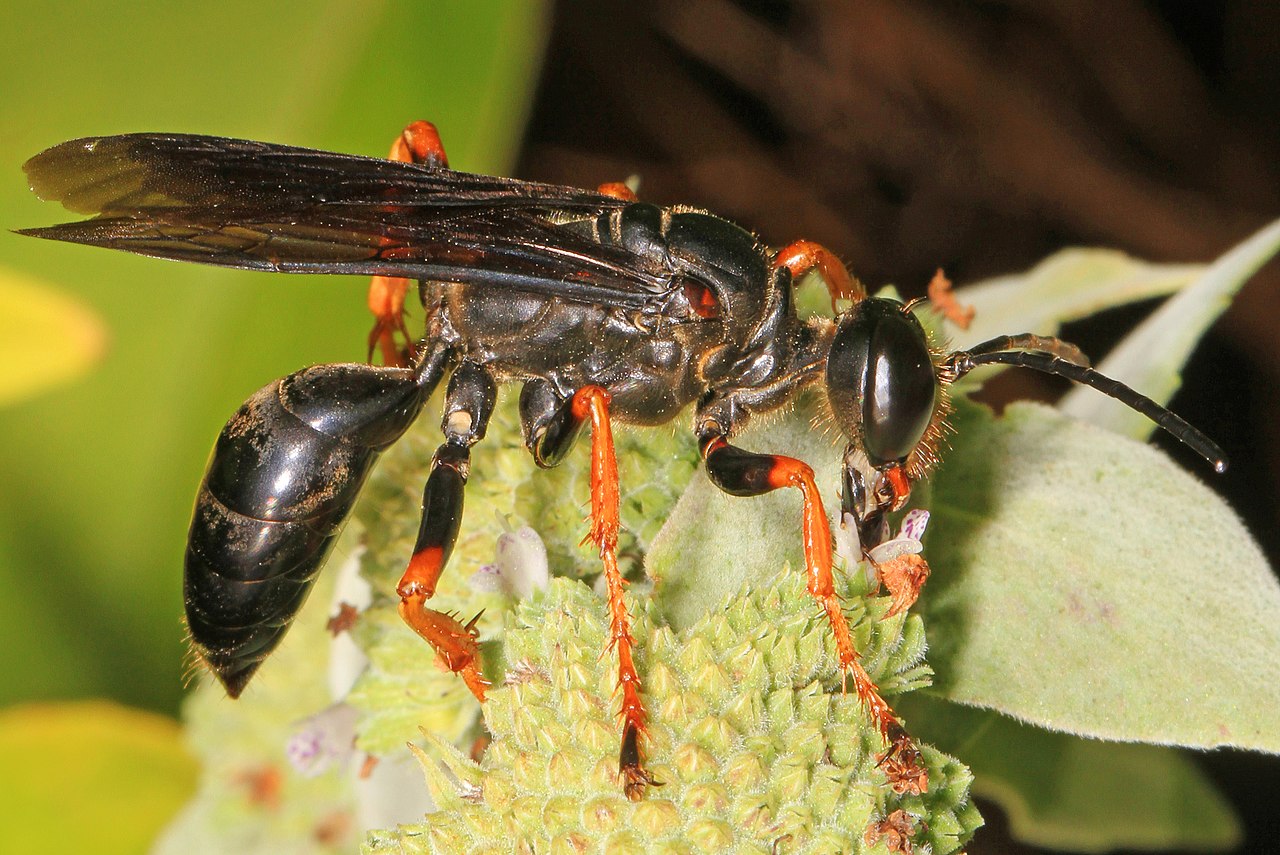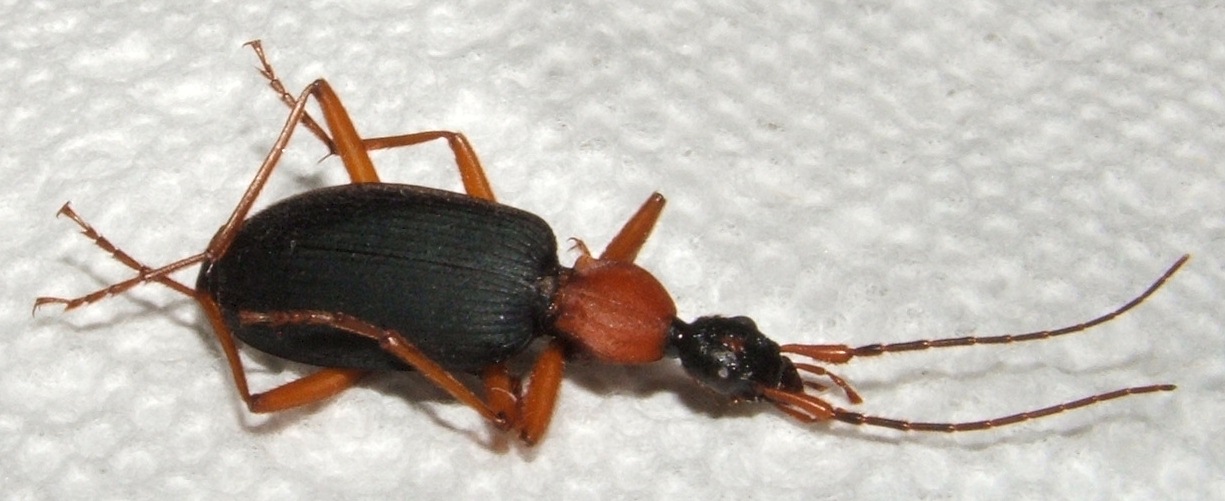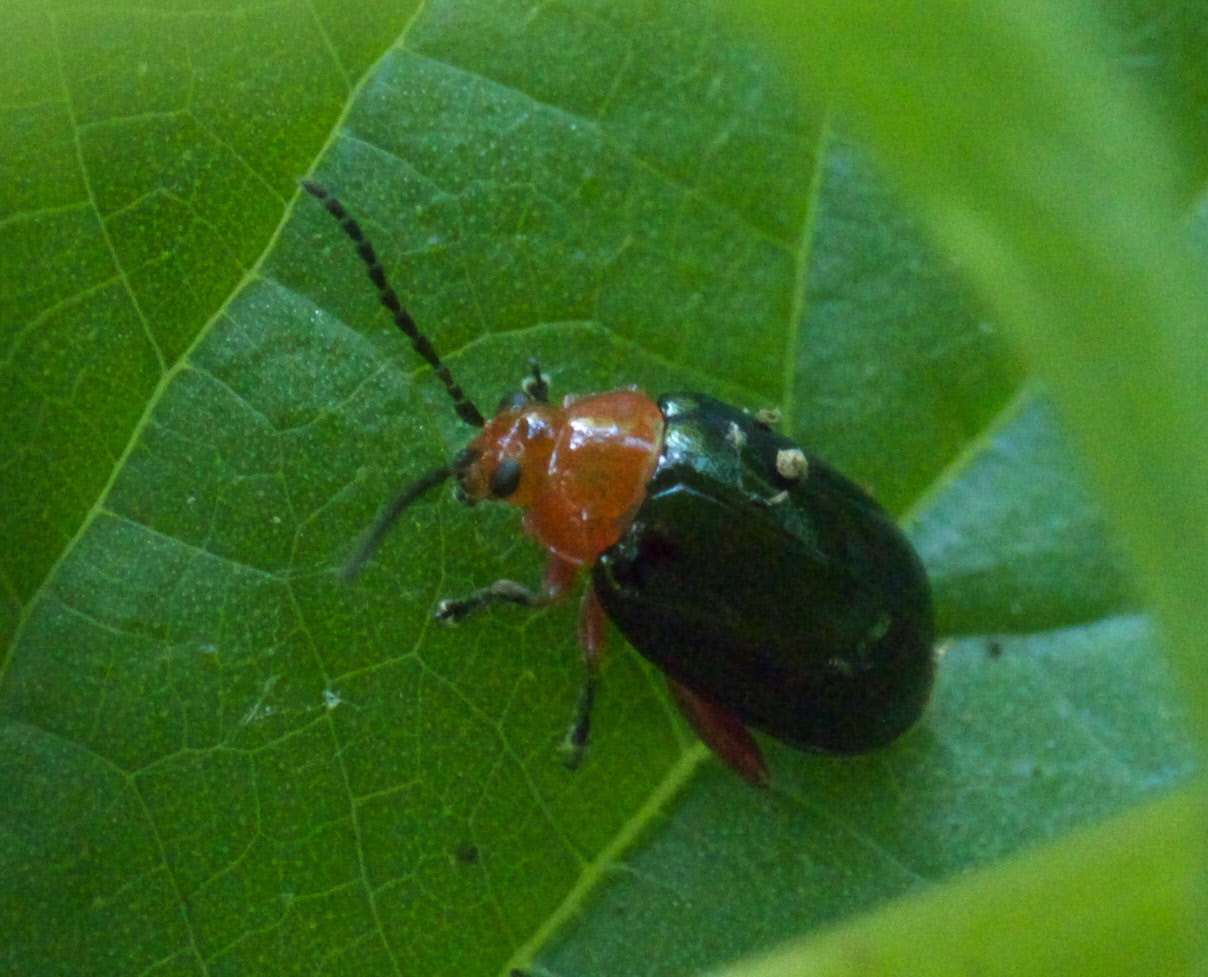The legs of various bugs often have the same color as the body or wings but many are differently colored.
Some bugs have red legs regardless of their main color. These bugs vary from ground crawlers to flying or even jumping species.
Bugs with red legs are found all around the world. Here are some of the most notable species with different red leg nuances.
Table of Contents
1. Red-Legged Purseweb Spider
Small but highly contrasting, Red-legged Purseweb Spiders (Sphodros rufipes) have red legs or orange legs.
Nuance differences are specific to each individual when it comes to the final color of their adult legs.
Growing to a size of up to 0.3 inches, Red-legged Purseweb Spiders have a mostly black shiny body.

More common than other garden species, Red-Legged Purseweb Spiders have a constant presence around walls and rocks where they build their funnel-like webs.
These spiders build atypical webs but their bright colors aren’t visible since they hide inside their funnel webs.
This species also stands out with its long fangs. Longer than in other species, its fangs look like a false pair of cerci right in front of its head.
2. Arrow-shaped Orbweaver

A species named after the appearance of its females, Arrow-shaped Orbweaver (Micrathena sagittata) come in red and dark red legs coloring.
It’s the females that have this leg nuance. Even more, male Arrow-shaped Orbweaver lake the abdomen spines on females and are rarely seen.
This is a web-building species that may also show dark red nuances along the arrow-shaped abdomen.
In addition, the abdomen itself can be yellow with red margins or bright red margins on some morphs of the species.
Its cephalothorax is also mostly red-brown or dark red with or without tiny yellow, white, or black spots.
One common trait across all of its morphs includes black spine tips’ coloring.
Further Reading:
3. Red-legged Grasshopper

A North American native, The Red-legged Grasshopper (Melanoplus femurrubrum) is among the most common grasshoppers on the continent.
Bright red legs or red-brown legs are seen on this species which typically has another coloring across its body.
Green and yellow colors are specific to its sides and head, together with different styles of black patterns.
Its mid-dorsal section shows red-brown coloring with additional black patterns.
A true herbivore, this type of grasshopper is found across all types of open areas with plenty of vegetation.
It varies considerably by age and food availability. It can struggle to reach 1 inch as an adult but it may also reach a full size of almost 3 inches in areas with abundant food.
4. Red-legged Buprestis

Red-legged Burprestis bugs (Buprestis rufipes) are also natives of North America.
This bug isn’t as common as some grasshoppers as it only feeds on dying trees.
It does show atypical coloring, on the other hand. Its legs are red or red-brown.
A metallic emerald green color is mostly specific to its dorsum.
Red-legged Buprestis bugs additionally show golden yellow spots across the wings. Tiny round spots as well as long golden stripes are noticed on its body.
Its presence on trees signals the host tree is dying or already dead. It can live off different trees including more common beech and acer.
Red-legged Buprestis are boring bugs in these host trees.
5. Redlegged Ham Beetle

This species (Necrobia rufipes) is also named after its red legs despite having mostly metallic blue or blue-green coloring.
Its legs have a dark blue nuance but aren’t metallic as its head and wings.
This is a type of meat-boring bug that goes after the insects that feed on decaying and stored meats and their eggs.
It eats flies and eggs and can even bore into smoked meat, something that not many other bugs can do.
The presence of Redlegged Ham Beetles on meat isn’t a good sign.
These considerable pests are even known to move away from ham to other types of meat such as fish. Considerable damages are caused to herring around the world.
While metallic, this is a type of bug that’s rather small. Most Redleggeg Ham Beetles measure around 0.15 inches.
6. Red-legged Spittlebug

This species (Prosapia ignipectus) comes in different morphs, all including red legs. The nuance of its legs can differ, on the other hand.
From pale red to vivid red, The Red-legged Spittlebug comes with different leg colors.
This is a species that also shows different elytra colors. From a full black to a black and yellow morph, the jumping bug can come in different variants.
There’s even a brighter gray and brown morph.
Some of its variants, such as the black and orange Red-legged Spittlebug, also come with red sections across the base of the wings.
Red-legged Spittlebugs are found on plants. Apart from the vivid color of their legs, these bugs also impress by jumping distances.
They can jump high and even jump distances a few times their body length, making a quick escape when needed.
7. Katydid Wasp

The Eastern United States is home to The Katydid Wasp (Sphex nudus).
Red legs are highly common on this type of large wasp. They come in different nuances of red as well as in rare bright brown and even yellow morphs.
Dark red legs are highly common on this wasp that feeds on various flowers.
Much of its appearance is mostly black while its head may show yellow, red, or brown patterns.
Its legs are also partly black, as they aren’t fully black in either of its morphs.
This stinging wasp also comes with black wings and not transparent wings like other similar species.
In addition, it also features thick black antennae.
8. Great Golden Digger Wasp

Red and red brown legs are common on The Great Golden Digger Wasp (Sphex ichneumoneus).
Named after the slightly golden or bright brown nuance on its mostly black body, this is one of the wasps that feed live insects to its young.
The species has red or red-brown legs and slightly darker brown wings. It additionally shows pure yellow-golden hairs along its upper body and head.
Females of the species dig burrows to lay eggs in.
They provision these burrows with grubs which serve as food for the emerging Great Golden Digger Wasp larvae.
Stinging females paralyze these grubs which are then flown or dragged into the burrow.
Females of the species possess painful stingers and they even show high aggression towards other females of the species.
9. False Bombardier Beetle

These types of beetles (Galerita bicolor) resemble true Bombardier Beetles by shape and color.
Red legs are highly specific to this species, together with a red thorax, a black head, and black wings.
This species is also identified by its very long antennae which are both red (at the base) and black (at the tips).
A small species found in decaying vegetation such as leaves on the ground in forests, False Bombardier Beetles are also found in parks and woodlands.
They prefer high moisture areas such as shaded places in gardens with plenty of decaying organic matter.
Female False Bombardier Beetles are further known to use mud to build their nests. These are small individual nests where eggs are safely laid away from the eyes of predators.
10. Master Blister Beetle

A species of the desert, Master Blister Beetles (Lytta magister) have red legs. Red nuances are also specific to the cephalothorax of the species while the elytra is black.
This is a type of bug that is adapted to the harshest living conditions with adaptations such as burrowing into the ground to escape the high desert heat.
Its reduced size of up to 1.3 inches helps the species also move into the crevices in the ground, location females favor when it comes to top spots for laying eggs.
Desert shrubs in North America provide the food adults prefer for Master Blister Beetles.
While small and while living in remote areas, these bugs should not be handled as they can bite, without serious consequences, however.
11. Shiny Flea Beetle

Many species of flea beetles around found in The Americas. Some are black while others are striped and multicolored.
Shiny Flea Beetles (Asphaera lustrans) have red legs and a red cephalothorax.
This species also comes in a yellow-brown variant of a similar pattern with black wings.
Bugs of this genus can be detrimental to plants in gardens. Eliminating them from the garden is also difficult.
Shiny Flea Beetles can overwinter with no activity in the ground. They emerge as soon as temperatures start to increase at the end of the winter.
These bugs are also present throughout the year in Central America.
12. Canada Fire-colored Beetle

Longer and larger than Shiny Flea Beetles, Canada Fire-colored Beetles (Dendroides canadensis) are also dark red and black.
Their dark legs are matched by a similar nuance cephalothorax and black wings. The head itself is black, as are its atypical antennae.
This type of beetle may be red and black, but it’s known for its capacity to survive cold winters in the Northern parts of North America.
Canada Fire-colored Beetles can even survive freezing temperatures.
Living among leaves on the ground, this is a species found throughout much of Canada and well as in the Eastern parts of The United States.
Reaching a size of 0.6 inches, the bug may be difficult to spot as it only comes out at night.
13. Virginia Metallic Tiger Beetle

A North and Central American native, The Virginia Metallic Tiger Beetle (Tetracha virginica) also has red legs.
This is a species showcasing different red nuances from bright to dark red.
Some of its morphs feature yellow or tan legs but the elytra have the same metallic green nuance.
The species also has small grooves on its elytra while its metallic green cephalothorax is mostly smooth.
A species that live next to water, The Virginia Metallic Tiger Beetle retreats in the ground during the day.
14. Forest Bug

Red-brown legs and a general matching red-brown color are characteristic of Forest Bugs (Pentatoma rufipes).
This is a shield-shaped species with an elytra that features a yellow or orange central dot.
Tiny vivid red dots are further visible just behind its head.
Its red nuances are impacted by the seasons as the bug becomes brighter in the summer.
In the breeding season, this species generally takes on a darker appearance but its legs remain red.
While some bugs of its species are specialized feeders, Forest Bugs eat the leaves of various trees such as oaks.
15. Red-legged Spider Wasp

Red-legged Spider Wasps (Episyron rufipes) live on beaches and in sandy areas that are easy to burrow in.
This is a species of black and white wasps with almost transparent wings and dark red legs.
Sometimes also found in European and Asian gardens, Red-legged Spider Wasps are named after they prefer eating spiders.
Adult females catch and paralyze spiders which are then laid as food for the species’ emerging larvae.
Adult wasps don’t eat spiders or insects, favoring plants and nectar.
Red-legged Spider Wasps grow to a size of 0.5 inches and they are often known to spend their time looking for spiders and then digging their nests.
Since burrowing in the sand is easy, these wasps may even leave the spider in a safe area after paralyzing it before returning to carry it to the now-completed burrow.
16. Common Red-legged Robberfly

Also, a European native, the Common Red-legged Robberfly (Dioctria rufipes) has dark red and black legs.
Little variation is seen among the individuals of the species which additionally have a red or red-brown ventral color.
This is a species that features an elongated body that widens towards the rear end. It also features characteristic golden hairs around the thorax while its wings are mostly transparent, with visible black veins.
Common Red-legged Robberflies feed on all types of wasps, especially parasitic wasps in the summer.
All types of other parasitic flies are also consumed by these insects.
They live in areas around woodlands or in other dense vegetation habitats most likely to offer different species of insects to feed on.